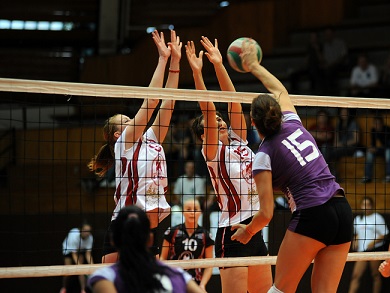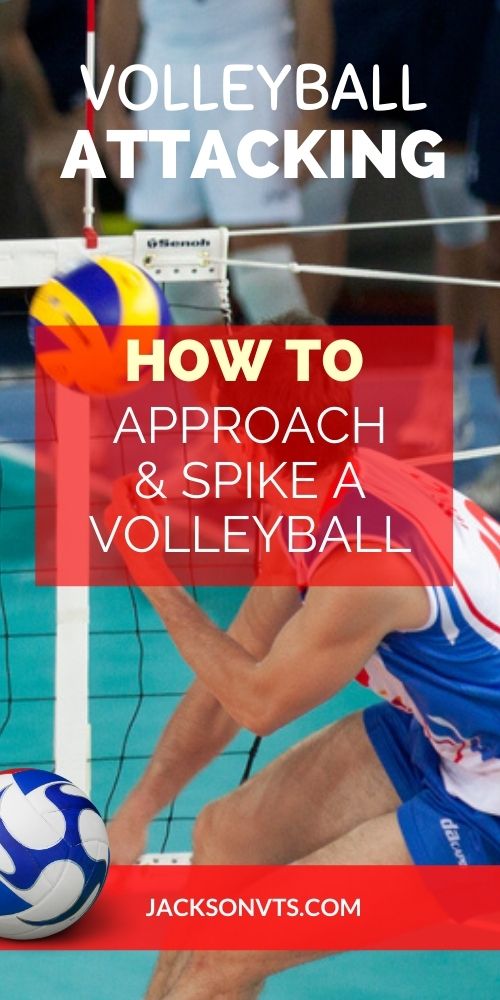The following are volleyball approach drills for beginners. These are critical for learning the correct footwork and spiking technique.
Approaching to Spike a Volleyball
Basic Footwork
The basic steps for the approach are…
- left-right-left for right-handers
- right-left-right for left-handers
There is also a one-legged spike technique called a slide.

Slow Motion Training
If you’re completely new to volleyball, or want to make major changes to your footwork, then it’s best to start with training in slow motion.
Over the River Volleyball Approach Drill
For this drill, you need to find a flat object such as a rug. The purpose of “over the river” is to master the steps while stepping over the river (in this case, the rug).
1st progression: First start out by just taking two steps over the rug. Right now, just focus on the last two steps of the approach. The last two steps are right foot then left foot. As you take the first step, be bringing your arms back. Bring your arms back, then land with quiet feet.
2nd progression: The next progression is to focus on the foot placement when landing. Think of placing the feet pointed more towards the sideline than forward. You almost want your front foot to be parallel to the net. Your back foot isn’t turned quite so much. Focus on quiet feet when landing and finishing in stance ready to bring your arms back forward and up.
3rd progression: Do everything as before, but now add in a jump. So now you’re bringing your arms forward and jump up high in the air.
4th progression: If your volleyball approach is looking good so far, you can add in a 3rd step. So now, instead of starting just behind the edge of the rug, now start a couple feet further back. All you’re doing now is starting on your right foot instead of your left foot so you can now do a three step approach.
5th progression: The next progression is to add in the hammer position. So now, do as you just did before, but now end in the hammer position. (Lower arm is vertical with arm cocked and ready to hammer)
Each of these progressions should be done in slow motion at first. The advantage of slow motion is the athlete becomes aware of how the body feels when moving. It’s also helpful to watch video of the approach done right. You can also film yourself approaching to see what you look like and see if you’re doing it right. A lot players don’t believe their technique isn’t good until they actually see it on film!
If you’ve developed a good arm swing and your approach is looking pretty good, it’s time to spike using a spike trainer.
If you enjoyed these tips and would like to keep it close to you at any time, just save this pin to your Pinterest Volleyball Training Board.

Elbow to Wrist
The elbow to wrist arm swing is the final piece of the volleyball spike. Elbow to wrist is the spiking motion you want to use to create hard and powerful spikes.
The elbow to wrist movement should be developed separate from the volleyball approach. The volleyball spike approach is a very technical skill and each phase should be broken down into chunks.
Focus on getting in the same position every time
Elbow to Wrist Arm Action
The elbow to wrist arm action is similar to “hammering a nail”.
Think of reaching up high to hammer in a nail. This is the motion to use when spiking a volleyball.
You’ve probably heard a coach say to “snap your wrist”. What “snapping” refers to is “whipping at the ball” putting force into it. Also like hammering a nail, putting force into the nail.
In the photo above, the spiker is in the hammer position, ready to hammer the ball.
The key to this movement is the movement from “elbow to wrist”. Think of not moving from shoulder to elbow, all the movement is from the elbow to the wrist.
Remember, this is the last motion of the spike approach.
Once this motion is developed, go back and take approaches and work on bringing it all together. Approach to the ball and hammer away!
Quick Tips for the Volleyball Approach and Spike
Volleyball footwork tip:
To help timing a high outside set, be on the left foot when the setter is releasing the ball. After the left step, bring the arms back, then step with the right foot to where the ball is going.
Tip for spiking a quick set:
It’s very important to watch where the ball is passed. You must watch where the ball is going. If you don’t know where it’s going, then you won’t know how to line up to hit the quick. It’s usually best to try and volleyball approach straight perpendicular to the net. You also need to watch the ball so you don’t run into the setter.
The steps to hit a quick are…
- hitter watches the ball passed,
- lines up straight,
- takes off the ground not next to or out to the side, but back a little behind the setter,
- jumping more straight up and not broad jumping.
Home › Techniques › Approach
